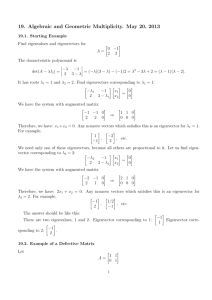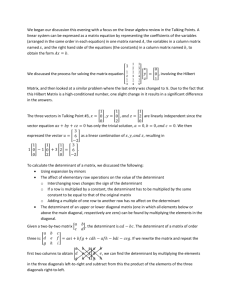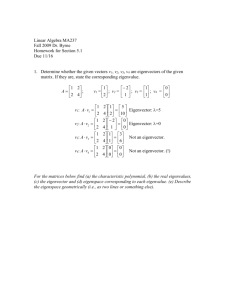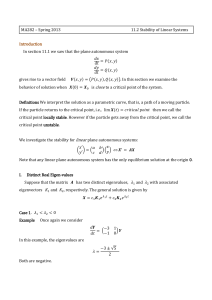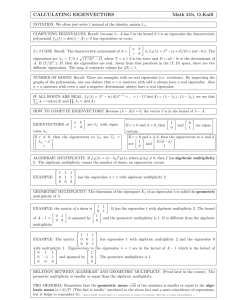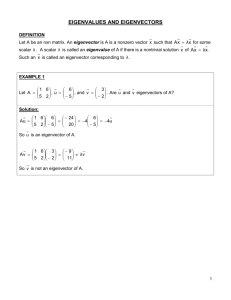Repeated Eigenvalues
advertisement
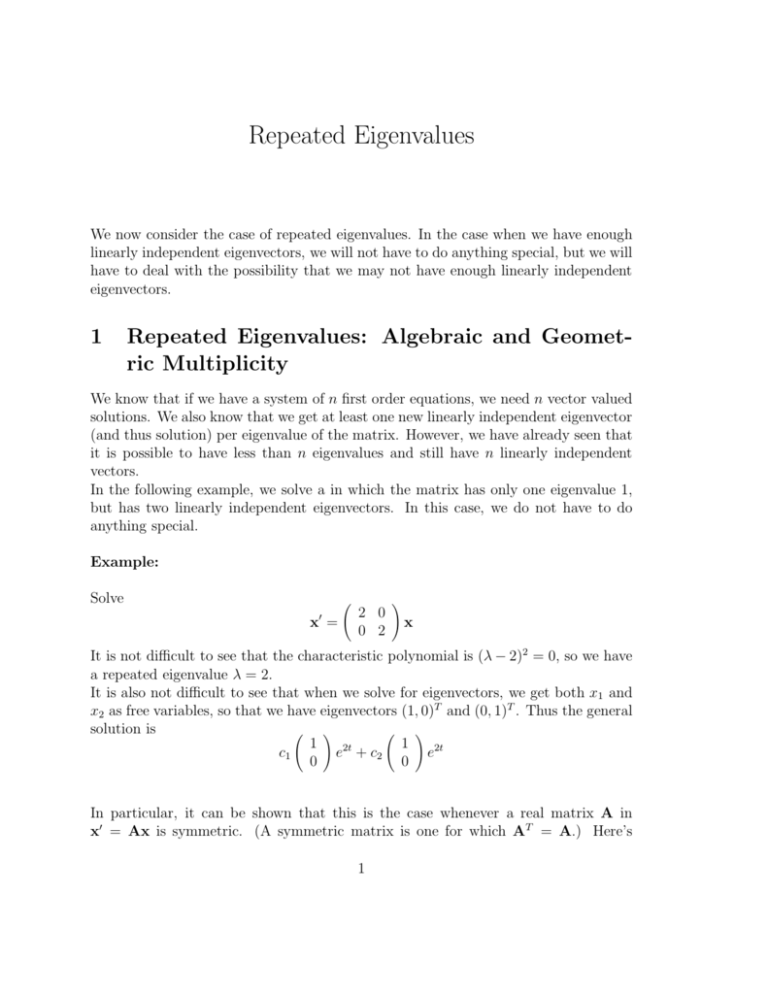
Repeated Eigenvalues We now consider the case of repeated eigenvalues. In the case when we have enough linearly independent eigenvectors, we will not have to do anything special, but we will have to deal with the possibility that we may not have enough linearly independent eigenvectors. 1 Repeated Eigenvalues: Algebraic and Geometric Multiplicity We know that if we have a system of n first order equations, we need n vector valued solutions. We also know that we get at least one new linearly independent eigenvector (and thus solution) per eigenvalue of the matrix. However, we have already seen that it is possible to have less than n eigenvalues and still have n linearly independent vectors. In the following example, we solve a in which the matrix has only one eigenvalue 1, but has two linearly independent eigenvectors. In this case, we do not have to do anything special. Example: Solve ′ x = 2 0 0 2 ! x It is not difficult to see that the characteristic polynomial is (λ − 2)2 = 0, so we have a repeated eigenvalue λ = 2. It is also not difficult to see that when we solve for eigenvectors, we get both x1 and x2 as free variables, so that we have eigenvectors (1, 0)T and (0, 1)T . Thus the general solution is ! ! 1 1 2t e2t e + c2 c1 0 0 In particular, it can be shown that this is the case whenever a real matrix A in x′ = Ax is symmetric. (A symmetric matrix is one for which AT = A.) Here’s 1 another example: Example: Solve 0 1 1 x′ = 1 0 1 x 1 1 0 It is not difficult to see that the characteristic polynomial is (λ − 2)(λ + 1)2 = 0, so we have a repeated eigenvalue λ = −1. It is also not difficult to see that when we solve for eigenvectors associated with λ = −1, we get both x2 and x3 as free variables: 0 v1 1 1 1 1 1 1 v2 = 0 0 v3 1 1 1 so that we have eigenvectors (−1, 1, 0)T and (−1, 0, 1)T . However, if we have an eigenvalue with multiplicity n which has less than n linearly independent eigenvectors, we will not have enough solutions. With this in mind, we define the algebraic multiplicity of an eigenvalue to be the number of times it is a root of the characteristic equation. We define the geometric multiplicity of an eigenvalue to be the number of linearly independent eigenvectors for the eigenvalue. Thus, in Example 1 above, λ = 2 is an eigenvalue with both algebraic and geometric multiplicity of two. However, it is possible for there to be less than n linearly independent eigenvectors if an eigenvalue is repeated. Example: Find all solutions of the form veλt to ′ x = 3 −18 2 −9 ! x The eigenvalues are given by 3 − λ −18 2 −9 − λ = (3 − λ)(−9 − λ) + 36 = λ2 + 6λ + 9 = (λ + 3)2 = 0 so we have only λ = −3. The corresponding eigenvector is given by solving 3 + 3 −18 2 −9 + 3 ! 2 v1 v2 ! = 0 0 ! Solving this system gives us just v1 = 3v2 , so we get only one linearly independent eigenvector, which can be represented as v = (3, 1)T . So we get only one solution 3 1 λt ve = ! e−3t Therefore, the algebraic multiplicity of λ = −3 is and the geometric multiplicity of λ = −3 is . When the geometric multiplicity of an eigenvalue is less than the algebraic multiplicity (as in Example 1), we say the matrix is defective. In the case of defective matrices, we must search for additional solutions. 2 Defective Matrices In the case of a defective matrix, we must search for additional solutions. Suppose we try the obvious generalization: Inspired by the case of repeated roots of the characteristic equation for second order equations, we search for a solution of the form vteλt . If we plug vteλt into the differential equation x′ = Ax, we get the following: d λt vte = A(vt) dt v(eλt + λteλt ) = Avteλt or rearranging and canceling out the eλt : v = (Av − λv)t However, this must be satisfied for all values of t, including t = 0. But this would imply v = 0, and this will not do. Recall that when we used reduction of order to find a solution teλt from the solution eλt , we actually got a solution of the form c1 teλt + c2 eλt , but we ignored the second part of the solution as it duplicated our original. It turns out that in the case of a system, we will not be able to ignore this second part of the solution. So we will consider solutions with both a teλt term, and an exponential term eλt , each with their own vector. So we try a solution vteλt + weλt Then, when we plug this into x′ = Ax, we get (vteλt + weλt )′ = A(vteλt + weλt ) veλt + vλteλt + wλeλt = Avteλt + Aweλt (v + λw)eλt + (λv)teλt = (Aw)eλt + (Av)teλt 3 Then we can equate the coefficients on teλt and eλt to see that we get the two equations Av = λv or (A − λI)v = 0 and Aw = v + λw or (A − λI)w = v The first equation simply says that λ and v are an eigenvalue and eigenvector pair for A. The second is a system to be solved. It can be shown that the system can always be solved for w. (The vector w is called a generalized eigenvector for A.) Example: Find the general solution to ! 3 −18 2 −9 ′ x = x We already determined that the only eigenvalue was λ = −3 and the corresponding eigenvector was v = (3, 1)T . To find our second solution, we need to solve (A − λI)w = v or 3 + 3 −18 2 −9 + 3 ! w1 w2 w1 w2 ! We row reduce the augmented matrix ! = = 6 −18 3 2 −6 1 3 1 ! ! Multiplying row one by 1/6 and row two by 1/2 yields 1 −3 1/2 1 −3 1/2 ! Subtracting row one from row two leaves us with the reduced system 1 −3 1/2 0 0 0 ! So we must have w1 − 3w2 = 1/2. Let us choose w2 = 0, so w1 = 1/2. Thus our generalized eigenvector is (1/2, 0)T , and our general solution is c1 veλt + c2 (vteλt + weλt ) 4 or c1 3 1 ! e−3t + c2 " ! 3 1 te−3t + 1/2 0 ! e−3t # Notice in the above that we cannot ignore the weλt term of the new solution, because w and v are not simply different by a constant multiple. Example: Solve the initial value problem 5 −4 0 ′ x = 1 0 2 x, 0 2 5 5 x(0) = 1 0 We start by finding the eigenvalues: 5 − λ −4 0 1 −λ 2 0 2 5−λ (5 − λ) = −λ 2 2 5−λ +4 1 2 0 5−λ = (5 − λ) [−λ(5 − λ) − 4] + 4(5 − λ) = −(5 − λ)2 λ = 0 +0 So we have two eigenvalues: We look for eigenvectors. With λ = 0, we matrix 5 −4 1 0 0 2 have to solve the system with augmented 0 0 2 0 5 0 We reorganize the rows, moving rows two and three up, and row one down to row three, which almost finishes our work: 1 0 2 0 0 2 5 0 5 −4 0 0 We then subtract five times row one from row three, and see that rows two and three are now constant multiples of each other: 1 0 2 0 5 0 0 2 0 −4 −10 0 5 So adding twice row two to row three, we get 1 0 2 0 0 2 5 0 0 0 0 0 Therefore, the eigenvectors must satisfy x1 + 2x3 = 0 and 2x2 + 5x3 = 0, with x3 a free variable. Choosing x3 = 2 allows us to have whole number answers x2 = −5 and x1 = −4, so we get eigenvector (−4, −5, 2)T for the eigenvalue 0. In the case where λ = 5, we must solve 0 −4 0 0 1 −5 2 0 0 2 0 0 Here, we can multiply row three by 1/2 column two: 0 1 0 and use it to eliminate al the other entries in 0 0 0 0 2 0 1 0 0 Thus, our equations reduce to x1 + 2x3 = 0 and x2 = 0, with x3 free. So a representative eigenvector is (−2, 0, 1)T . We have only two linearly independent eigenvectors, but a system of three equations and three functions. Thus, we must look for a generalized eigenvector for the repeated eigenvalue λ = 5. We need to find a vector w such that or −2 w1 0 −4 0 1 −5 2 w2 = 0 1 w3 0 2 0 So we tackle the augmented matrix 0 −4 0 −2 1 −5 2 0 0 2 0 1 1 −5 2 0 0 2 0 1 0 −4 0 −2 or rearranged: We use row two to eliminate row three, and add 5/2 row two to row one, leaving 1 0 2 5/2 1 0 2 0 0 0 0 0 6 Thus we have w1 + 2w3 = 5/2 and 2w2 = 1, with w3 free. Setting w3 = 1, we get a generalized eigenvector (1/2, 1/2, 1)T . Thus, combining our three solutions, we get 1/2 −2 −2 −4 5t 5t 5t c1 −5 + c2 0 e + c3 0 te + 1/2 e 1 1 1 2 (Recall that (−4, −5, 2)T was associated with the eigenvalue λ = 0.) To satisfy the initial conditions, we must have x(0) = (5, 1, 0)T . Plugging in t = 0 gives us 5 −4c1 − 2c2 + 12 c3 −5c1 + 21 c3 x(0) = = 1 0 2c1 + c2 + c3 This is the same as solving the system represented by the augmented matrix −4 −2 1/2 5 −5 0 1/2 1 2 1 1 0 After row reductions, we obtain 1 0 0 0 0 1 0 −2 0 0 1 2 So we get a solution with c1 = 0, c2 = −2, and c3 = 2. 7
